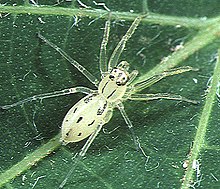
Jumping spiders or the Salticidae are a family of spiders. As of 2019, it contained over 600 described genera and over 6000 described species, making it the largest family of spiders at 13% of all species. Jumping spiders have some of the best vision among arthropods and use it in courtship, hunting, and navigation. Although they normally move unobtrusively and fairly slowly, most species are capable of very agile jumps, notably when hunting, but sometimes in response to sudden threats or crossing long gaps. Both their book lungs and tracheal system are well-developed, and they use both systems. Jumping spiders are generally recognized by their eye pattern. All jumping spiders have four pairs of eyes, with the anterior median pair being particularly large.
Goleba is a genus of African jumping spiders that was first described by F. R. Wanless in 1980.
Nebridia is a monotypic genus of Venezuelan jumping spiders containing the single species, Nebridia semicana. It was first described by Eugène Louis Simon in 1902, and is only found in Venezuela. It was briefly considered a synonym of Amphidraus, it was elevated to genus status in 2017.

Nicylla is a monotypic genus of Sumatran jumping spiders containing the single species, Nicylla sundevalli. It was first described by Tamerlan Thorell in 1890, and is only found on Sumatra. Briefly considered a synonym of Thiania, it was elevated back to genus status in 2017.

Onomastus is a genus of Asian jumping spiders that was first described by Eugène Louis Simon in 1900. It is the only genus in the subfamily Onomastinae.
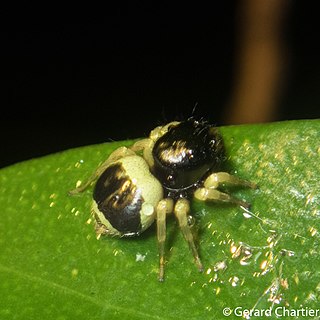
Pystira is a genus of spiders in the jumping spider family Salticidae.
Thianitara is a genus of Southeast Asian jumping spiders that was first described by Eugène Louis Simon in 1903. As of August 2019 it contains only two species, found in Thailand, Indonesia, and Malaysia: T. spectrum and T. thailandica. It was briefly considered a junior synonym of Thiania until 2017, when it was revived by Jerzy Prószyński.
Wallaba is a monotypic genus of Guyanese jumping spiders containing the single species, Wallaba metallica. It was first described by Cândido Firmino de Mello-Leitão in 1940, and is found in Guyana. It was synonymized with Sidusa in 2015, but was revalidated by Jerzy Prószyński in 2017.

Zenodorus is a genus of the jumping spiders distributed from the Moluccas to Australia, including several islands of the Pacific. It was once considered a junior synonym of Omoedus, but this was later rejected by Jerzy Prószyński in 2017. At least one species, Z. orbiculatus, specializes on hunting ants.
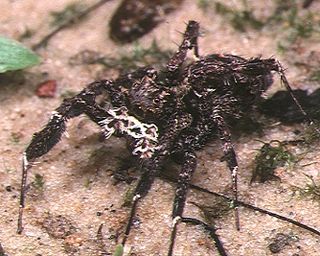
The Spartaeinae are a subfamily of the spider family Salticidae. The subfamily was established by Fred R. Wanless in 1984 to include the groups Boetheae, Cocaleae, Lineae, Codeteae and Cyrbeae, which in turn were defined by Eugène Simon.
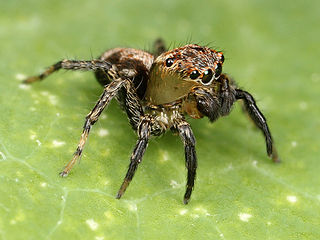
Salticinae is a subfamily of jumping spiders. It includes over 90% of the known species of jumping spiders. The subfamily is divided into two unranked clades: Amycoida and Salticoida.

Lyssomaninae is a subfamily of jumping spiders. It includes four genera, three from the New World.

Simonellini is a tribe of spiders belonging to the Amycoida clade of the subfamily Salticinae of the family Salticidae. The group has been treated at a variety of formal and informal ranks, with different circumscriptions, including as the subfamilies Synemosyninae and Simonellinae. Its species mimic ants and beetles.
Hermosa is a genus of spiders in the family Salticidae. It was first described in 1892 by George and Elizabeth Peckham. As of 2019, it contains 7 species.
Nepalicius is a genus of spiders in the family Salticidae. It was first described in 2016 by Prószyński. As of 2017, it contains 3 species.
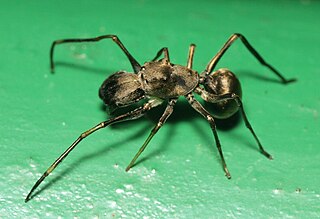
Toxeus is a genus of jumping spiders first described by Carl Ludwig Koch in 1846. The genus was synonymized with Myrmarachne by Eugène Simon in 1901, and remained a synonym until revived by Jerzy Prószyński in 2016, when he split up Myrmarachne.
Padillothorax is a genus of southeastern Asian jumping spiders first described by Eugène Simon in 1901. As of April 2019 it contains only two species.
Matinta is a genus of South American jumping spiders. The largest number of species are found in Brazil.

Hisponinae is a subfamily of jumping spiders. The subfamily has six known extant genera and three extinct genera.
